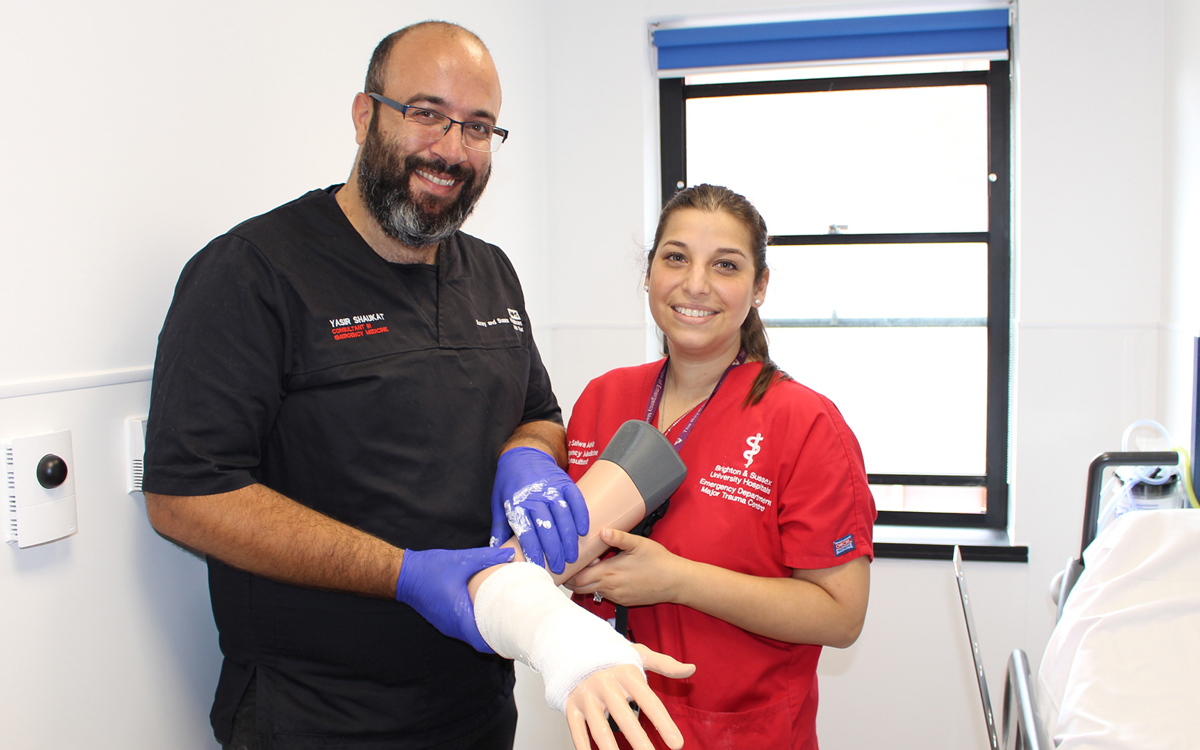Meeting the brains behind the Colles' Fracture Reduction Trainer
In the first excursion of its kind, we visited the two masterminds behind the Colles’ Fracture Reduction Trainer.

Ten years ago, Dr Salwa Malik and her brother-in-law Dr Yasir Shaukat had a brainwave. Having just spent a day in A&E as part of her first rotation as a junior doctor, Salwa realised she hadn’t been trained to reduce a Colles’ Fracture. Given that Colles’ fractures, or a fracture occurring at the distal end of the radius, comprise of between 12% to 17% of all fractures, it’s an important technique to not only know, but perfect.
Sitting alongside Dr Shaukat and her very own Colles' Fracture Reduction Model, Dr Malik recalls what was running through her mind: “The one opportunity I did have (to perform a Colles’ fracture reduction), my consultant just said, ‘pull it as hard as you can’ and that was literally my training. I came home and I said to Yasir ‘I’m hopefully going to be doing A&E training, I don’t feel comfortable that I don’t know how to do this’”. Dr Shaukat, working in Orthopaedics at the time, did his best to explain the procedure, but it was quickly apparent that without a physical representation of the fracture, any explanation falls short of being sufficient. Dr Malik turned to Dr Shaukat and said “Wouldn’t it be so cool if there was a model which we could just do this on?”, and the general consensus was ‘let’s make this happen’. That was the moment the Colles’ Fracture Reduction Trainer was essentially born.
“I could picture it straight away” said Dr Shaukat. “This was the best idea you have had so far!”, he exclaimed to Dr Malik as both consultants shared a moment of laughter. And now that very idea has become a reality. But how did things progress from the initial ‘lightbulb moment’? “We were pointed to Limbs because NHS innovations thought it was a company that was going to carry it through; it was a simulation model that would be in their grasp to develop and make, and then put the resources and time into and that made it well worth us approaching you guys about it”, said Dr Malik. It has been a long process; as aforementioned, it has been a development that has been in the pipeline for ten years. In that time, both Dr Shaukat and Dr Malik have worked closely with our Research and Development and Product Management teams to ensure their vision is realised in a practical, efficient and cost-effective manner. They both admit that the process has enlightened them, as Dr Shaukat explains: “It was quite nice for us to be fully involved in the design process. It’s a brilliant product in my eyes, and that’s largely down to the fully clinical involvement with Limbs & Things, and their expertise on how to build products.”

Dr Shaukat (far left) and Dr Malik (middle right) explain the procedure to a trainee
There is a belief that the Colles’ Fracture Reduction Trainer has a place in every emergency department across the world. Such is the frequency of the injury and the subsequent procedure, there is an inherent need for a suitable training solution, which in turn eliminates complications and the need for corrective surgery. At the Brighton and Sussex University Hospitals Trust, they’ve had access to one for some time now, albeit a prototype. So, what’s been the effect? “It’s an element of confidence first of all for juniors”, Dr Malik expresses emphatically. She continues: “We have had a look at the educational value of it and the educational value has said every single time that they (the junior doctors) are much more confident, they feel more competent, and that leads to more successful reductions. The more that they feel they that they can do it independently, the more they will be successful in doing it. It’s a complex procedure that we’re not taught about in a lot of detail at medical school. You saw how many people ended up having to be involved in that procedure; just teaching someone how to do it – there’s quite a lot involved.” It’s a sentiment Dr Shaukat echoes and expands upon: “It’s opportunity as well, as with any field, especially in the medical field, when you do procedures, you get better every single time and you learn and learn, and your expertise level goes up, but only after doing so many of certain procedures.”
Dr Malik finishes by saying: “This is an amazing opportunity. Having gone through the medical school side and having not had the opportunity, I think this would have increased my confidence before starting out, and I just feel excited that this is something that could actually benefit so many healthcare professionals. We’re just looking forward to seeing it do its thing.”
And you can see Colles’ Fracture Reduction Trainer do its thing, too.
Did you like this article?
Share it on social media today, and remember to tag us!

